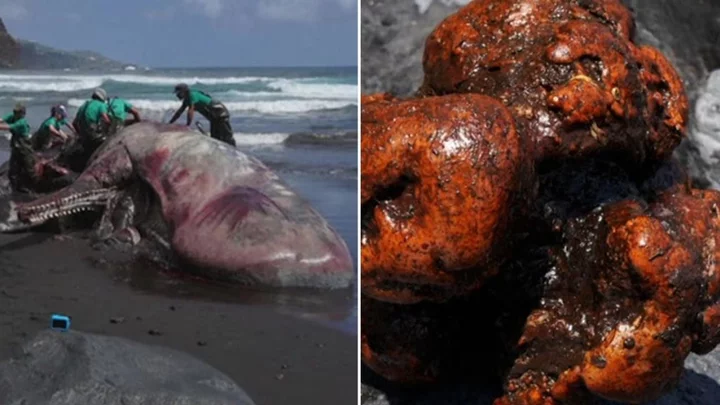
Nasa has found ‘diverse organic matter’ on surface of Mars
Nasa has discovered “diverse organic matter” on the surface of Mars, which could change our understanding of the red planet and the search for life in the universe. The Perseverance rover made the discovery in the Jezero Crater on Mars and a number of different explanations for the existence of the material have been posited. The materials could have been formed when water and dust interacted, or was dropped onto the planet by dust or meteors. Authors of the new study also refused to rule out that the materials are “biotic”, or came about due to the existence of life on the surface. Sign up to our free Indy100 weekly newsletter The findings could have a big impact on the continued search for alien life, with research into the organic matter on the surface telling us more about the existence of carbon sources on Mars. The Jezero crater has been explored by The Scanning Habitable Environments with Raman and Luminescence for Organics and Chemicals (Sherloc) instrument on the rover since February 2021. The crater is the site of an ancient lake basin and all 10 target sites explored within it came back with signs of organic molecules. Even if the materials are not biological in origin, research into them could be crucial in the search for alien life, according to the researchers. “Not all organics are biological in origin. Observing spatial relationships between minerals and organics is necessary when evaluating organic origins and potential biosignatures. Everything we know of life on Earth is limited to what is preserved in the rock-mineral record. On Earth, biosignatures are found in certain minerals and some minerals are better at preserving organics than others,” said Ashley E Murphy, a researcher at the Planetary Science Institute and co-author on the new paper. “Mars may have had a similar early geologic history to Earth so we use our knowledge of life as we know it on Earth for where to look for potential evidence of past life on Mars. Mapping organics allows for a better understanding of if the Martian carbon cycle is similar to or different from Earth, and the potential of Mars to host life.” Writing in the Nature journal, the authors said: “Our findings suggest there may be a diversity of aromatic molecules prevalent on the Martian surface, and these materials persist despite exposure to surface conditions. “These potential organic molecules are largely found within minerals linked to aqueous processes, indicating that these processes may have had a key role in organic synthesis, transport or preservation.” The findings are published in a new article, ‘Diverse organic-mineral associations in Jezero crater, Mars’, in Nature. Have your say in our news democracy. Click the upvote icon at the top of the page to help raise this article through the indy100 rankings.
1970-01-01 08:00

Atlantic, Pacific Storms Churn as Las Vegas Boils: Weather Watch
It’s a tale of two ocean travelers this Friday: Subtropical Don in the Atlantic and Hurricane Calvin in
1970-01-01 08:00

Scientists uncover supergiant ’space ghost’ in night sky
Scientists have been studying a “space ghost” which could be due to explode in just a few decades, changing the night sky forever – if it hasn’t already, that is. The object in question is a large star called Betelgeuse and the scientific community is divided over whether or not it’s already become a supernova. One theory states that the light from Betelgeuse takes so long to reach Earth it could mean the huge explosion has already taken place. Betelgeuse has been a supergiant red star for an estimated 40,000 years, but that could change relatively soon. Sign up to our free Indy100 weekly newsletter Michael Shara is the curator of astrophysics at the American Museum of Natural History. He told the US Sun: "Betelgeuse lies somewhere between about 450 and 550 light years from Earth." He went on to say: "Betelgeuse’s position appears to change slightly, as seen from Earth, between June and December, when the Earth is on opposite sides of its orbit around the Sun. "That tiny change in position is a direct measure of the distance to Betelgeuse." He went on to expand on the theory by saying: "Let's assume that Betelgeuse is precisely 500 light years distant. "If Betelgeuse exploded as a supernova anytime in the past 499 years, the light from that event has not yet had enough time to reach Earth…so we have no way of knowing if Betelgeuse has already blown up. "If, for example, Betelgeuse blew up in 1600 AD, we won’t know about it until the year 2100. But if it blew up on August 1, 1523, then on August 1, 2023 it will become about as bright as the full Moon. "The only naked eye supernova of the past century occurred in 1987… all astronomers would be thrilled and delighted if Betelgeuse (or another dying star) graced our night sky with a supernova in the coming decades." Have your say in our news democracy. Click the upvote icon at the top of the page to help raise this article through the indy100 rankings.
1970-01-01 08:00

Why trolling the likes of Andrew Tate is actually earning them money
Since Elon Musk’s takeover of Twitter, many controversial users who were previously banned from the platform have been allowed back on and are flourishing. Users such as Andrew Tate have regained a platform to spout his harmful views to millions of users. But, while it may feel satisfying to troll such users, engaging with their tweets actually earns them money. Here’s why: Twitter recently announced it was paying out thousands of dollars in advertising revenue to users to “benefit” from their high engagement on tweets, earning more money the higher their engagement is. As part of Twitter’s Ad Revenue sharing program, users require “5M+ Tweet impressions in each month for the last 3 months”. Sign up to our free Indy100 weekly newsletter On Thursday (13 July), some eligible users began receiving notifications of how much money they would receive. The highest earner, Dogecoin co-founder Billy Markus, known online as Shibetoshi Nakamoto, earned $37,050. Tate also revealed in a tweet that he earned $20,379 from ad revenue generated in the reply threads under his posts. The money comes from the ad revenue generated in their replies below the content they post on the platform, and is paid out via the Stripe account that the user registered for creator subscriptions with. Twitter staffer, Patrick Traughber, said: “Excited to start sending our first payments to creators for ads revenue sharing today. “Creators are the lifeblood of this platform, and it's great to see so many creators I follow getting paid today. The program will be expanding soon—more to come!” The cash payouts come just a week after Meta launched its rival text-based platform, Threads. Have your say in our news democracy. Click the upvote icon at the top of the page to help raise this article through the indy100 rankings.
1970-01-01 08:00

India’s Third Moon Mission Lifts Off as Space Race Intensifies
India launched an uncrewed mission to the lunar surface, joining the US, China and others in a new
1970-01-01 08:00

Doctors reattach boy's head after suffering 'internal decapitation'
Doctors have performed a minor miracle after re-attaching a “'decapitated” boy’s head after he was hit by a car. The miraculous surgery occurred after Suleiman Hassan, a Palestinian boy from the West Bank, was severely injured after being hit by a car while out riding his bike. He was airlifted to Hadassah Ein Kerem’s Trauma Unit in Jerusalem and went straight to surgery. He suffered what is known as an internal decapitation – this occurs when the base of the skull and top of the spine become detached by the skin remains intact. This extremely rare injury can occur when a strong, sudden impact on the head results in the muscles and ligaments that hold the head in place to sever, accounting for less than one per cent of spinal injuries. Sign up to our free Indy100 weekly newsletter Doctors explained that Hassan’s head was “'almost completely detached from the base of his neck” before he underwent painstaking surgery taking several hours. The procedure involves reattaching the skull and spinal column using technology such as screws, rods, plates and bone grafts. One of the surgeons who operated on Hassan, Dr Ohad Einav, told The Times of Isreal: “We fought for the boy’s life.” Dr Einav continued: “The procedure itself is very complicated and took several hours. While in the operating room, we used new plates and fixations in the damaged area… “Our ability to save the child was thanks to our knowledge and the most innovative technology in the operating room.” Surgeries such as the one that saved Hassan’s life are only possible if internal decapitation victims have their major blood vessels intact, keeping the brain alive. Hassan’s surgery took place in June but has only recently been made public as the boy continues to recover at home with rehabilitation. Miraculously, Hassan can walk unaided and has no neurological problems following the shocking injury. Have your say in our news democracy. Click the upvote icon at the top of the page to help raise this article through the indy100 rankings.
1970-01-01 08:00

Scientists have discovered that humans can actually hear silence
It is possible for human beings to hear silence, according to a team of philosophers and psychologists, in a huge win for 1960s crooners Paul Simon and Art Garfunkel. In a study published on Monday by Johns Hopkins University researchers, the team decided that it’s not just sound that human hears pick up: silence is, indeed, something we can hear too. Rui Zhe Goh, a Johns Hopkins graduate student in philosophy and psychology who was the study’s lead author, wrote: "We typically think of our sense of hearing as being concerned with sounds. But silence, whatever it is, is not a sound — it's the absence of sound. Surprisingly, what our work suggests is that nothing is also something you can hear.” Sign up to our free Indy100 weekly newsletter Per the study, published in the journal PNAS, researchers had participants listen to an array of audio illusions. They also periodically substituted the noise for pure nothingness, the measure whether people’s brains would react in the same way. “Philosophers have long debated whether silence is something we can literally perceive, but there hasn’t been a scientific study aimed directly at this question,” said study co-author Chaz Firestone, an assistant professor of psychological and brain sciences and the director of the Johns Hopkins Perception & Mind Laboratory. “Our approach was to ask whether our brains treat silences the way they treat sounds.” "If you can get the same illusions with silences as you get with sounds, then that may be evidence that we literally hear silence after all." The 1,000 participants’ responses were measured across seven different tests. Across all of them, their brains reacted the same way to silence as they did to noise. “We show that silences can 'substitute' for sounds in event-based auditory illusions,” said the study. “Seven experiments introduce three 'silence illusions,' adapted from perceptual illusions previously thought to arise only with sounds.” “In all cases, silences elicited temporal distortions perfectly analogous to their sound-based counterparts, suggesting that auditory processing treats moments of silence the way it treats sounds. Silence is truly perceived, not merely inferred,” it said. “The kinds of illusions and effects that look like they are unique to the auditory processing of a sound, we also get them with silences, suggesting we really do hear absences of sound too,” added study co-author Ian Phillips, a John Hopkins philosopher and psychologist. Hello darkness my old friend… Have your say in our news democracy. Click the upvote icon at the top of the page to help raise this article through the indy100 rankings.
1970-01-01 08:00

'Alarming and unprecedented' Irish bird flu warning
Hundreds of seabirds with suspected avian flu have been found dead in recent weeks.
1970-01-01 08:00

10 Surprising Facts About Rogue Waves
These freak waves are rare and unpredictable—and are believed to have caused numerous shipwrecks.
1970-01-01 08:00

Europe Risks Becoming Dependent on Air Conditioning in a Hot World
European countries are among the least prepared in the world for more hot days in a 2C warmer
1970-01-01 08:00

Satellite Firm Viasat Stock Falls After ‘Unexpected’ Deployment Event
Viasat Inc. shares fell as much as 36% Thursday, on track for a record drop if losses hold,
1970-01-01 08:00

Scientists discover rare amount of 'floating gold' inside giant whale carcass
Scientists have discovered a huge amount of hidden treasure inside a gigantic whale carcass that washed up on a beach of the Canary Island of La Palma. A sperm whale was found to have a staggering £425,000 worth of 'floating gold' in it's stomach which an expert believes contributed to the creature's death. Antonio Fernández Rodríguez, the head of the institute of animal health and food security at the University of Las Palmas, studied the corpse and although local authorities were stumped by the whale's death, he put it down to one thing: ambergris. After studying the animal's colon, Rodriguez said that he managed to find a hard. object stuck in its intestine which he managed to cut out. Sign up to our free Indy100 weekly newsletter Rodriguez said: "What I took out was a stone about 50-60cm in diameter weighing 9.5kg. When I dissected and removed the stone I turned around and everyone on the beach looked at me in surprise, but for me at that moment I understood where the origin of the infection was coming from. "The waves were washing over the whale. Everyone was watching when I returned to the beach but they didn’t know that what I had in my hands was ambergris." However, ambergris isn't like the stereotypical type of gold or treasure that you would usually associate with the sea, or even pirates for that matter. Ambergris, is a prize possession of perfumers around the globe, hence its value, and is made up of undigested squid and cuttlefish that the whale has vomited. Even though it sounds disgusting, the extremely rare substance is actually said to smell of wood, and this particular piece of ambergris was reportedly worth €500,000 (£425,000). The university are now hoping to find a buyer for the item with fund set to go towards the victims of the 2021 La Palma volcano eruption. Rodriguez adds: "The law is different in every country. In our case, I hope the money will go to the island of La Palma, where the whale ran aground and died." Have your say in our news democracy. Click the upvote icon at the top of the page to help raise this article through the indy100 rankings.
1970-01-01 08:00
